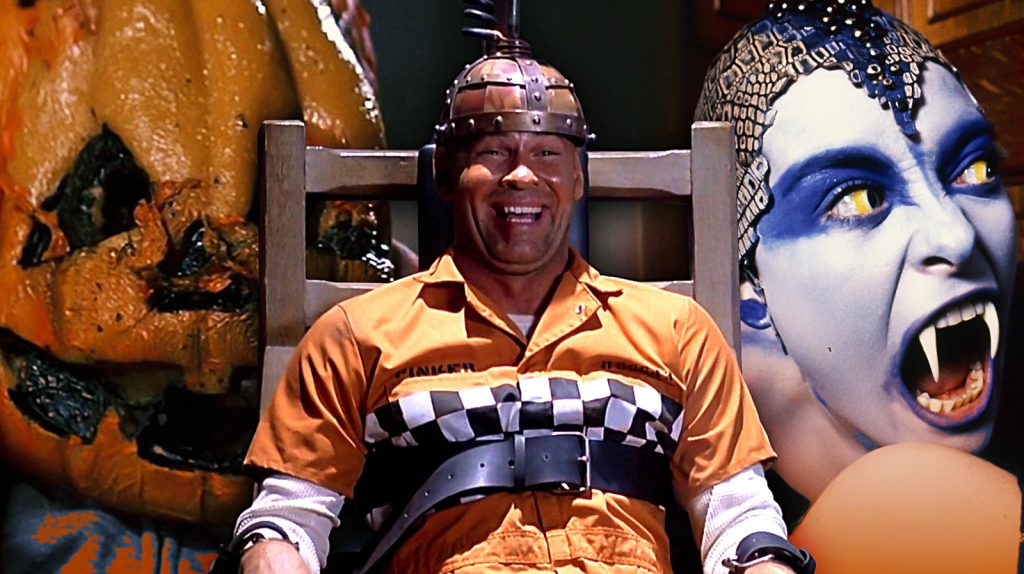
We could obtain a fee on purchases constructed from hyperlinks.
There could also be no different decade extra instantly related to basic horror in most people consciousness than the Nineteen Eighties. That is the last decade of the slasher genre-shaping “Friday the thirteenth,” of Freddy Krueger famously saving New Line Cinema with “A Nightmare on Elm Avenue,” of Sam Raimi blowing open the doorways of impartial filmmaking with “The Evil Useless,” and of dead-on-arrival bombs turned cult classics like John Carpenter’s “The Factor.”
The corruption of the Ronald Reagan presidency, if nothing else, proved to be fertile floor for the horror style’s dread and bloodshed. However as all the time, not all movies are created equal — and neither is the general public’s reception to them. The ’80s are chock-full of unseen or under-appreciated gems that stand as much as the canonized classics of the period, from disregarded franchise sequels to ignored ventures from American and worldwide style masters. There is a wealth of riches (and blood, guts, hacking, slashing, creatures, monsters, ghouls, goblins, ghosts, and so on.) to be discovered inside what seems like an limitless depth of hidden ’80s horror treasures.
Listed here are probably the most underrated ’80s horror films that you have to watch.
Society
Here is a horror film for anybody who enjoys feeling completely sick to their abdomen whereas taking of their night leisure. “Society” is likely one of the best — and grossest — shows of disgusting physique horror ever unleashed on theater screens, and it additionally serves as a pointy skewering of an America that, by 1989, had additional cemented itself as a hierarchical landmine of wealth inequality.
We comply with Invoice Whitney (Billy Warlock), an on a regular basis teen in Beverly Hills whose unease towards his rich household is confirmed justified when he begins to suspect they may be concerned in some form of freaky sex-murder cult. His paranoia-fueled quest to uncover the secrets and techniques lurking beneath the polished floor of his life could not probably put together him — or the viewer — for the prolonged climax that defines the film’s total filmic ethos. Producer of Stuart Gordon’s first film, “Re-Animator”, Brian Yuzna, making his directorial debut, groups up with legendary horror results artist Screaming Mad George to ship a finale of carnal, fleshy insanity that rivals probably the most stomach-churning entries within the physique horror style.
The result’s a placing piece of ’80s horror that is as grotesque as it’s perceptive in its depiction of sophistication disparity, a niche that may solely widen within the a long time to comply with. The elite could not really be partaking in erotic, body-melding orgies, however the truth that the premise of “Society” feels instantly believable says so much all by itself.
Halloween III: Season of the Witch
It is no shock that while you label your film “Halloween III” and fail to ship the eerily stalking menace of Michael Myers, audiences may bounce proper off it. As a substitute of suburban slashing, “Halloween III: Season of the Witch” provides a totally totally different form of horror story — one which baffled moviegoers in 1982. Had they merely dropped the “III,” this third entry within the John Carpenter and Debra Hill-produced franchise may need discovered success by itself phrases. Alas, it might take a long time for “Halloween III: Season of the Witch” to earn its cult following.
Meant as the primary in a brand new anthology sequence underneath the “Halloween” banner, “Halloween III” was a standalone story that bombed laborious sufficient to convey Michael Myers again in “Halloween IV: The Return of Michael Myers.” However even with out the franchise baggage, “Season of the Witch” is bizarre sufficient {that a} polarizing response was most likely inevitable. Tom Atkins performs an alcoholic physician who groups up with Stacey Nelkin to research unusual goings-on in Santa Mira, California, the place the Silver Shamrock Novelties firm is pushing a line of Halloween masks for teenagers — with sinister intent.
The movie blends science fiction and supernatural horror in a narrative involving androids, shadowy males, and a plot to revive historic pagan rituals of mass sacrifice. The subtitle “Season of the Witch” barely is sensible, however that provides to the unusual attraction. Director Tommy Lee Wallace leans into the bizarre, crafting a spooky, singular entry in ’80s horror that feels tailored for that acquainted chill of October. Contemplating its competitors, “Halloween III: Season of the Witch” could also be one of the best “Halloween” sequel.
Possession
Polish director Andrzej Żuławski’s surrealistic supernatural horror movie was met by a cool reception and restricted launch in 1981. Right now, in sure circles, “Possession” is taken into account a horror basic. A divorce drama by the use of gonzo theatricality, enigmatic plot developments, and completely deranged sequences of metaphysical and creature horror, “Possession” is a film that asks viewers to carry on for expensive life because it makes its manner by its manic story of the dissolution of two lovers.
Made amid Żuławski’s personal torrid divorce, it reads as an existential panic assault, with the director positioning the dynamic between his two leads in any extreme manner essential to get the utmost quantity of impression from their private afflictions, externalizing the demons they’ve absorbed from their creator into atrocious, complicated beasts and effusions.
Sam Neill as Mark tries to take care of the ever-slipping actuality of his world towards the more and more unstable Anna, performed by Isabelle Adjani in probably the greatest and most uninhibited horror performances of all time. She is the centerpiece of one of many best scenes of berserk bodily lunacy ever dedicated to movie, as Anna writhes round screaming and shrieking amid her personal bodily secretions within the filth of a subway tunnel. By the point it introduces doppelgängers, it ought to be no secret that “Possession” is an acquired style, however those that perceive its unrestrained rhythms will discover a horror film representing a singular sort of reckless abandon.
The Past
Lucio Fulci’s “The Past” will get to the center of the kind of surreal aberration that usually accompanies Italian horror. A Southern Gothic supernatural thriller a few Louisiana lodge which will or might not be located on a gateway to hell, “The Past” sees Fulci at his most disorienting and legitimately scary, carving out a imaginative and prescient of a world that’s doomed to a hellish destiny that it has no management over.
He accomplishes this by way of his dependable sense of nightmarish imagery and jarring moments of violence, and amplifies it by way of a discombobulating plot, making the viewers really feel as hopelessly misplaced and confused because the characters trying to navigate their manner by an inescapable condemnation. “The Past” delivers on each horror set piece you may ever hope for with ravishing, brutal sensible results, together with ravenous tarantulas, skewered eyeballs, zombies clawing their manner again to Earth, and a remaining liminal threshold realm that carries a heavy, disturbing weight of inevitability. It is probably the greatest Italian horror films of all time.
Prince of Darkness
The center chapter of John Carpenter’s so-called “apocalypse trilogy” — by chance beginning with “The Factor” and rounding out with “In The Mouth of Insanity” — “Prince of Darkness” doubtlessly finest represents the inevitable cosmic doom that encompasses the runtimes of every movie. It options a number of the legendary horror director’s most unsettling imagery and homes the best existential sense of terror of his total physique of labor, anchored round a broadcast from the longer term foretelling imminent, inescapable wreck.
Carpenter expands his sense of terror from the immediacy of Michael Myers’ blade or the morphing type of an alien life kind right into a slow-burn, simmering pressure as a bunch of quantum psychics graduate college students investigates an ominous container of liquid in a monastery that seems to be the bodily manifestation of Devil. Carpenter is not myopic sufficient to not afford such a heightened idea a sure diploma of tongue-in-cheek consciousness, and there is some comedian aid on behalf of our incredulous and ill-fated protagonists. However then that simply makes the last word sense of dread Carpenter imparts as occasions drag on much more unsettling, as a easy understanding of the world is ruptured by the arrival of evil forces a lot better than any of those characters might ever deal with.
The Lair of the White Worm
You possibly can solely actually set correct expectations for “The Lair of the White Worm” if you happen to’re conversant in the work of its director, the usually controversial and eccentric Ken Russell. The English filmmaker was recognized for his blasphemous inclinations, sexual perversions, and mind-altering surrealism discovered inside startling non secular dramas (“The Devils”), sci-fi head-trips (“Altered States”), and wackadoo horror comedies, corresponding to “The Lair of the White Worm.”
Loosely primarily based on Bram Stoker’s 1911 novel of the identical title, “The Lair of the White Worm” is a folks horror story that carries an undercurrent of droll humor about its personal ridiculous nature. It follows a slew of residents in rural Britain — together with early-career roles from a baby-faced Hugh Grant and Peter Capaldi — as a supernatural conspiracy involving a monstrous serpent is unveiled inside their peaceable hamlet. It is by no means significantly horrifying, nevertheless it does fulfill the Ken Russell quota of weird, freaked-out blended media hallucinogenic, sexually-charged horror set-pieces.
And, sure, there may be finally a large sensible worm monster that persons are sacrificing virgins to, in addition to a batch of characters working round with prosthetic fangs. Russell devises a heightened creature function simply self-aware sufficient to make its horror parts really feel genuinely unusual and uncanny, leading to the kind of film solely he might make.
Whats up Mary Lou: Promenade Night time II
The primary “Promenade Night time” movie is a reasonably forgettable piece of acquainted ’80s slasher fare, principally capitalizing on the presence of its stars Leslie Nielsen and Jamie Lee Curtis whereas by no means exceeding the standard of a few of its extra spectacular contemporaries. On the flip facet, the underseen seven-year-later sequel “Whats up Mary Lou: Promenade Night time II” builds on that movie’s base premise to craft what’s secretly one of many nice horror sequels.
To be truthful to audiences, there isn’t any cause to suppose that “Whats up Mary Lou: Promenade Night time II” is any good: it acquired expectedly blended evaluations, has a little bit of a low-rent aesthetic, and initially began manufacturing as a meta horror referred to as “The Haunting of Hamilton Excessive,” solely rebranding to a “Promenade Night time” sequel after in depth reshoots. However although it might initially appear to be a cheapie cash-in on the recognition of a second-rate slasher, “Whats up Mary Lou” is definitely a crazed, sleazy possession image to fit in with a number of the better of the subgenre, appearing as a shameless amalgamation of “The Exorcist,” “Carrie,” and “A Nightmare On Elm Avenue,” and taking the story to the absurd extremes that such a mix implies.
It is a movie filled with memorable imagery and kills, and options Michael Ironside offering extra gravitas than is probably deserved, in addition to Lisa Schrage, wild because the provoked protagonist who turns bloodthirsty, suggesting an important profession that by no means bought off the bottom.
Shocker
Freddy Krueger could also be Wes Craven’s best horror creation to have come out of the ’80s, however I believe it is excessive time that we pay our respects to Horace Pinker (Mitch Pileggi) of “Shocker.” Moreover, Pinker and Krueger really feel harmonious with one another, making “Shocker” rhyme a lot with “A Nightmare on Elm Avenue” at the same time as two separate compositions.
“Shocker” seems like Craven throwing the rules of ’80s horror, and of his personal filmography, on the wall and seeing what sort of form the splatter takes on. It is about 10 totally different positively deranged films all synthesized collectively right into a loopy techno-slasher freak out, with Craven sustaining the dream logic of “Elm Avenue” and pushing it to madcap heights. I doubt you will discover many different slashers centered on a serial killer who turns to black magic to evolve right into a bodily manifestation of electrical energy who can possess folks at will, out to kill a youngster with whom he has a psychic connection. Oh, and that teen (Peter Berg as Jonathan Parker) additionally has a supernatural hyperlink to his ghost girlfriend, who involves him in visions.
You will have thought you’ve got seen all of it by the climax, which then as soon as once more upends your expectations because it pits our characters on a frantic chase with one another by tv stations. At each flip, true to his total physique of labor, Craven has a brand new, wild concoction up his sleeve, and “Shocker” is overdue for its horror flowers.
Inferno
Italian horror maestro Dario Argento adopted up his masterpiece and shock 1977 hit “Suspiria” with the second film in his “Three Moms” trilogy (the final one, “The Mom of Tears,” could be delayed till 2007), impressed by Thomas de Quincey’s “Suspiria de Profundis.” With a botched North American theatrical launch and blended evaluations coming off the rousing success of his instantly earlier work, “Inferno” was left in a chief place for many years of neglect.
That is a disgrace, as a result of “Inferno” is Argento at a few of his most visually beautiful, atmospherically haunted, and completely raving and perplexing. “Inferno” sees Argento stripping his model all the way down to the naked necessities: centered on a supernatural story of homicide and witchcraft, that includes the identical masterful use of fantastically lurid, neon lighting established in “Suspiria,” and composed of his reliably fantastic sequences of bloody pressure.
Argento has by no means been significantly recognized for compelling character work, and with this entry, you will particularly need to verify your expectations on the door so far as partaking dialogue or a coherent plot. Quite the opposite, “Inferno” fairly proudly performs up its baffling perposterousness, very happy to drop all these ancillary parts of filmmaking to ship a vivid temper piece that coasts on its ambient vibes.
From Past
Earlier than directing “Society,” Brian Yuzna produced this H.P. Lovecraft adaptation, directed by horror legend Stuart Gordon. “From Past” reunites Gordon with Jeffrey Combs and Barbara Crampton following “Re-Animator” for a gross-out physique horror extravaganza that is as a lot an exhibition of corporeal grotesquerie as it’s a journey into kinky sexual liberation.
The story facilities on the event of a machine that stimulates the pineal gland, unlocking entry to a parallel dimension teeming with violently carnal creatures keen to soak up a bunch of unprepared scientists into their world of savage ecstasy. When lead scientist Dr. Edward Pretorius is reworked by this alternate actuality and returns to the lab, it is as an impossibly revolting, moist, mutated monster bent on devouring minds and guiding others towards his grotesque imaginative and prescient of enlightenment.
“From Past” might not be overly scary, nevertheless it’s pushed by a gleeful sense of dangerous style and a agency dedication to fusing violence with sexual perversion. That includes a number of the most memorable sensible results in horror historical past, it is a vivid reminder of a time when horror was a bit extra tactile— and much more bonkers.




